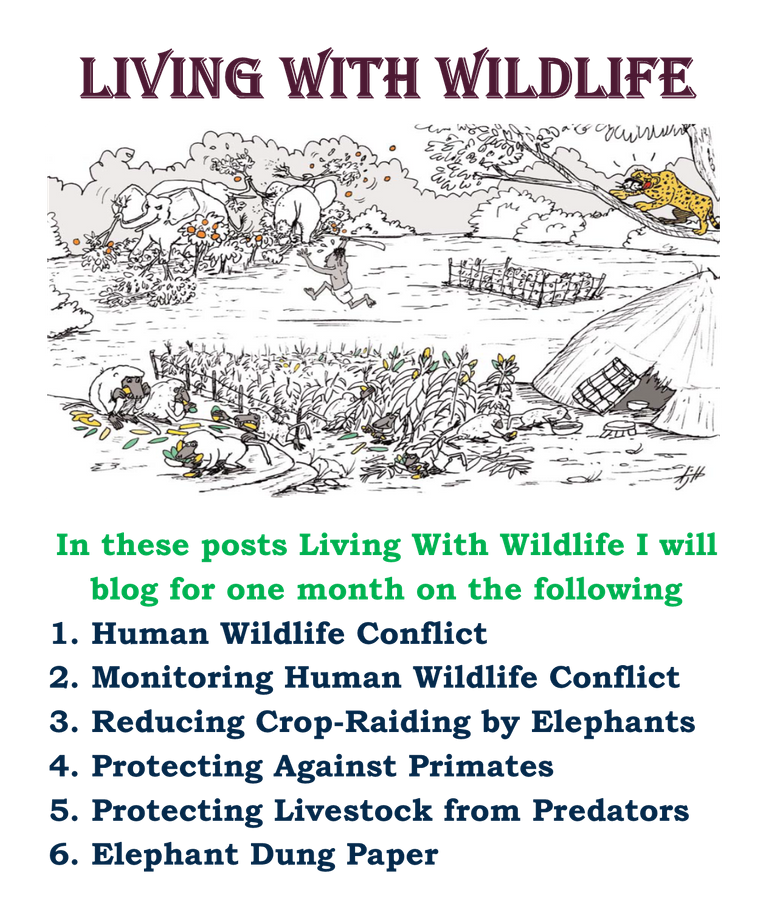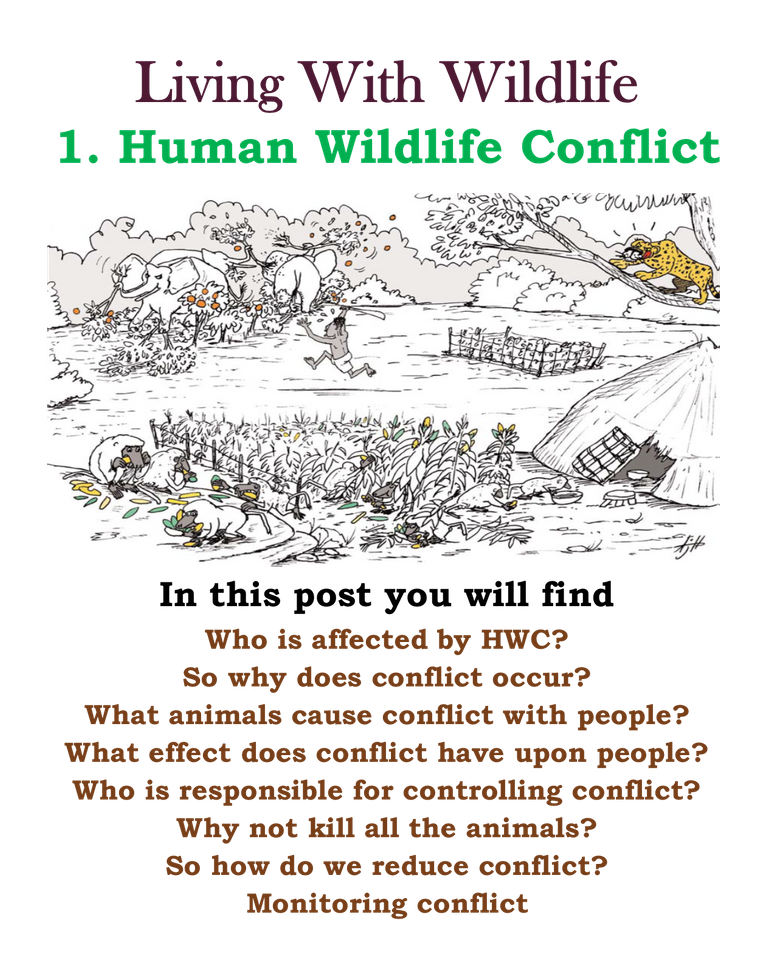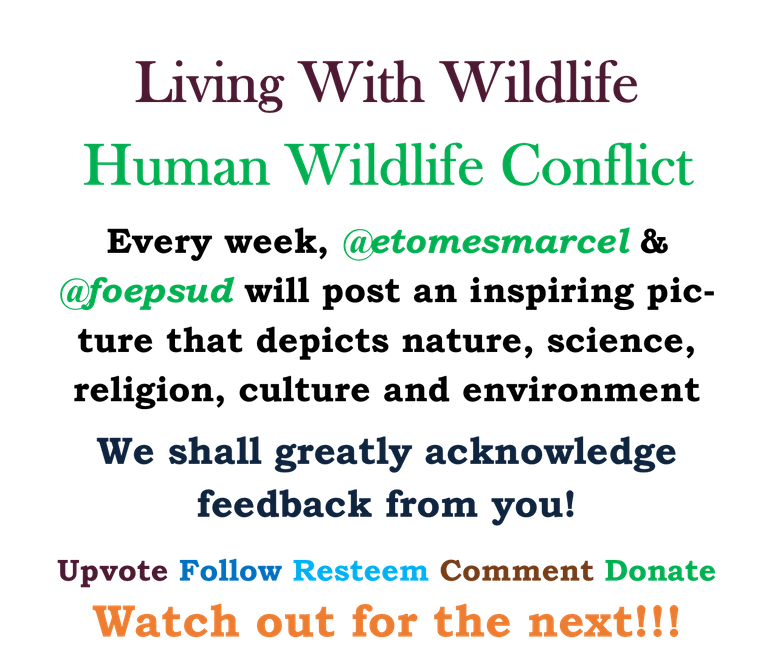LIVING WITH WILDLIFE
HUMAN WILDLIFE CONFLICT
Human-Wildlife Conflict (HWC) describes any situation where wild animals cause problems for people. Wild animals may damage people’s crops, they may destroy people’s houses and property, and they may even endanger people’s lives. There are many different forms of conflict, but they are all similar in that they have a negative effect upon the people involved. Wild animals that cause conflict with people are often called ‘problem animals’.


Who is affected by HWC?
HWC happens across the world, from bears raiding dust bins in American suburbs to chimps raiding crops in the forests of central Africa. Wherever people and wildlife come into contact there is potential for conflict. However, the people who are most likely to be affected are those living in remote villages surrounded by woodland where many animals live. In Africa, rural farmers suffer from conflict with wildlife because they share the landscape with wild animals.
So why does conflict occur?
Many of the big animals of Africa need large areas of land to survive. National parks do not always cover all the land which these large animals need and so they move outside the parks. But people have settled on the land that wild animals once used and this is one reason why animals like elephants and buffaloes come into conflict with humans. In other cases people have settled around sources of permanent water and in the dry season the animals are forced to enter the villages in order to drink.
What animals cause conflict with people?
In Africa a wide range of animals cause problems for people. Many animals raid crops: elephants and buffaloes eat all food crops; monkeys and baboons eat maize and fruits; bush pigs love potatoes and groundnuts; and birds eat the seeds from sorghum. Large and dangerous animals such as hippos and elephants may injure or kill people. They move around at night so that people living nearby are often too scared to travel after dark. Elephants and buffaloes may use the same waterholes as people. When the animals are there, people may be too scared to use them. Lions and hyenas may eat people’s cattle and goats, and may also attack people occasionally.
What effect does conflict have upon people?
HWC makes it more difficult for a farmer to survive.When animals damage crops or eat livestock, they are making it harder for a farmer to feed his or her family.Subsistence farmers will rely upon the food they grow to see them through the rest of the year, and if there is not enough they will face serious problems. The same applies when livestock are killed by wild animals. But the most serious form of conflict is when someone is killed by a wild animal.
Who is responsible for controlling conflict?
The national government is usually responsible for controlling problem animals. However, in some situations, local government or local committees are also involved. The most common way of dealing with problem animals is either to scare them away using gun shots or to build fences to protect crops and livestock. In serious cases the problem animal may be shot. However, these methods are not always very effective. Animals stop being scared of gun shots and may find ways to break through fences. Where animals have been shot and killed, others often take their place.
Why not kill all the animals?
Wild animals are part of the African environment - without them, the landscape would change and some of these changes could hurt people (see Box 1). In addition, wild animals have other values.Some people make money from showing these animals to tourists who have nothing like them in their own countries. In some areas, community projects are funded by money from wildlife hunting, which provides direct benefits to local people. Many people believe that wildlife is important for its own sake and for the cultural and religious importance it holds. They argue that the world would be a poorer place without it. Finding ways to live with wildlife will help protect the whole environment for the benefit of humans and animals alike.
So how do we reduce conflict?
The best way to reduce conflict with wildlife is to use a combination of different methods. Conflict reduction methods are known as deterrents, because they aim to deter (stop) the animal from causing the problem. For example, if elephants are damaging your crops then you can build fences and form co-operative guarding groups. You can try new methods such as chilli dung bricks and bangers. You should also seek assistance from game scouts if they are available in your area. By using a variety of new and traditional methods you stand the best chance of protecting your crops and livestock against wildlife.


Great post with little exposure and please we need to talk a bit about tagging coz its very important in bringing out the education in such great posts.
Ok shall get to you
Nice write up very educative. As humans continue to invade animal habitats then animal human conflict will bound to happen on a daily bases.
@manka
content creator
Thanks Manka for your comments
Nice write up, we only need to always be conscious of our activities on biodiversity so as to always strike a balance